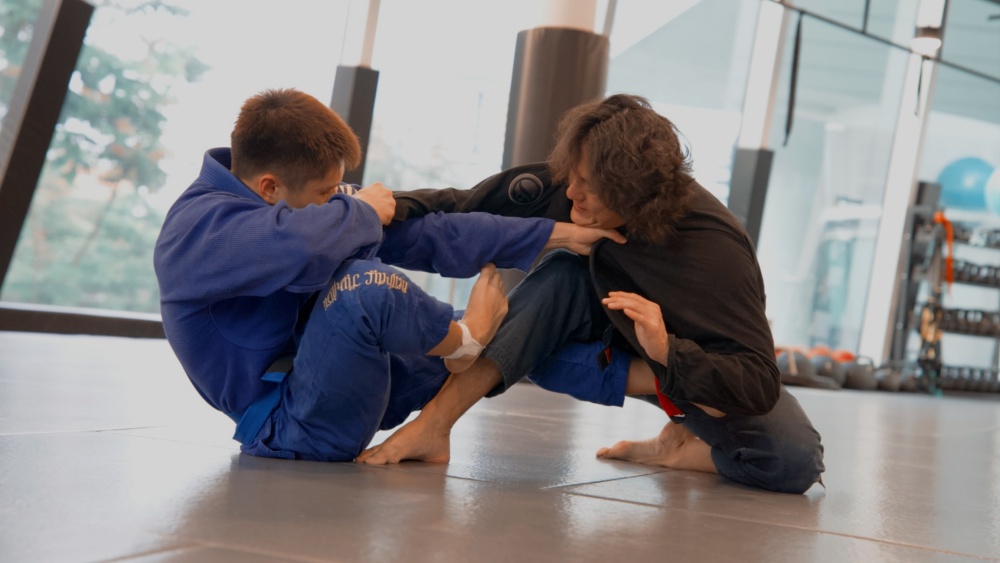The toe hold is one of the most popular leg attacks in Brazilian Jiu-Jitsu. It is a move that is typically seen in colored belt matches and is an unexpected technique that can end a match in an instant. Regarded as a classic leg attack not only in BJJ but also in other grappling styles, the toe hold is known for its effectiveness in creating painful pressure on the ankle and foot. Mastery in escaping this submission is crucial for any practitioner looking to advance their grappling skills and protect themselves during competition and training. This article covers five strategic escapes from the toe hold, offering insights and techniques to enhance your defensive game.
1) Early-Stage Reactions
The key to escaping any submission in BJJ, including the toe hold, starts with early recognition and reaction. The moment you notice your opponent attempting to isolate your foot for a toe hold, immediate action is required. The first line of defense is to prevent your opponent from securing a deep grip on your foot.
Reacting effectively means removing all possible ways for the opponent to lock in the submission while simultaneously making quick adjustments in your positioning to increase the distance between your foot and your opponent. By preventing the firm grip, you diminish their control and reduce the effectiveness of the toe hold.
In today’s meta, it is typical to see grapplers use leg entanglements (ashi garami) to isolate the leg before they go for a leg submission. If you find yourself trapped in a leg entanglement, you must know several ways to remove the hold. The opponent will do whatever it takes to keep you trapped inside the entanglement, which opens up the threat of submission.
This strategy of using early-stage reactions will significantly improve your chances of not getting submitted. It is far easier to defend against loose submissions than escaping from tight ones.
2) Rolling Escape
One common and useful technique for escaping a toe hold is to roll in the direction of the applied pressure. This movement can help unwind the grip and alleviate the strain on your foot. As soon as you feel the toe hold being applied, initiate a roll towards the side where your toes are being twisted.
This tactic not only helps in potentially loosening the grip but also may allow you to invert and escape or transition into a more advantageous position. However, this method requires caution and awareness of your surroundings to prevent worsening the situation or falling into a more compromising position.
3) Using The Boot
The “boot” is a simple yet effective defensive technique against leg locks, including the toe hold. This escape method involves flexing your foot to straighten it as much as possible, making it harder for your opponent to apply the necessary bend to secure the toe hold. By stiffening and straightening your leg and foot, you create a form of resistance that can disrupt the mechanics of the toe hold.
When applying the boot, ensure that you’re also trying to retract your leg towards your body or moving into a position where you can apply counter-pressure against your opponent’s grip. This might involve shifting your hips or rotating your body to alleviate the pressure.
4) Counter-Attacks
Turning the tables on your opponent by initiating a transition (or even a counter-submission) can be a valid escape strategy. As your opponent focuses on securing the toe hold, they may expose parts of their body, particularly their legs or feet. This presents an opportunity to apply a counter-submission, such as an ankle lock or a heel hook.
To execute this, you must be proficient in leg entanglements and quick to seize the moment. Engaging in a submission battle can be risky, but it often forces your opponent to abandon their attack to defend against yours. This not only serves as an escape but also shifts the momentum of the match in your favor.
Another option is to take the opponent’s back, as shown in the video by Lachlan Giles. It is a good idea to always look for opportunities to transition to better positions. Many tend to forget, but you can use this approach to counter an opponent’s attack.
5) Escaping To A Safe Position
When other escape methods are not viable, moving to a safer position can be your best bet. This involves using your hands to manually untangle your opponent’s grip and pushing their legs away to free your foot. Once you’ve managed to loosen their hold, immediately transition into a safer grappling position, such as standing up or moving into top control.
The effectiveness of this method greatly depends on your ability to remain calm and utilize precise hand movements to disrupt your opponent’s technique. It requires practice to execute smoothly under pressure.
Importance Of Drilling
It is not enough that you know these defensive maneuvers; diligently drilling is the best way to become more accustomed to defending toe hold and other leg attacks, for that matter. Leg locks can be risky and have the potential to cause significant harm. Ensure that you put enough time into practicing your defensive tactics so that you can safely move from defending the submission to starting your offense.
If you are new to the leg game, we encourage you to drill these techniques for several months, focusing on the critical details mentioned above. Talk to your coach and training partners so that they can help you in your development.
Conclusion
Mastering the escapes from a toe hold in BJJ enhances your defensive capabilities and overall confidence and competence on the mat. Each method discussed strategically responds to one of the more feared submissions in grappling. Practitioners should train these techniques regularly and under various scenarios to fully integrate them into their repertoire.
As with all aspects of BJJ, the key to success lies in understanding the mechanics of the hold and the timing of your escapes. Through consistent practice and intelligent training, you can transform your defense into an asset that complements your attacking game.
You may also like:
Using The Grapevine To Build A Crushing Mount Game In BJJ & MMA

















